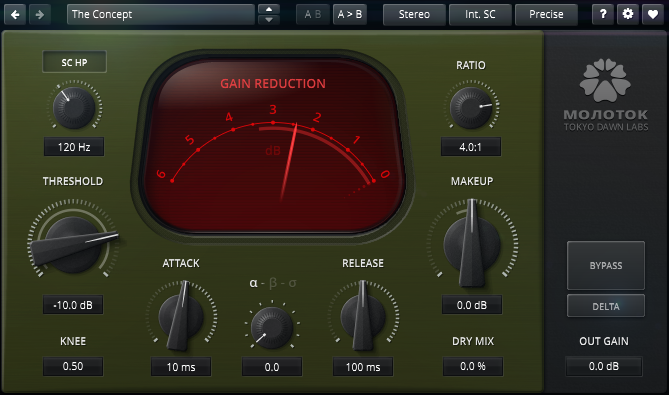The Concept
Molotok, a simplified version of TDR Molot GE, is a musically characterful dynamic processor. Meaning “Small Hammer” in Russian, Molotok offers a rich range of musically exciting compression colors controlled by a compact intuitive interface.
While Molotok doesn’t emulate any “vintage” device, its sound and behavior were inspired by their most interesting musical peculiarities. This flexibility makes it a rewarding choice for almost any source in the mix, be it drums needing more crisp and impact, solidification and enrichment of vocals, or the enhancement of guitar and bass recordings of all types.
Molotok relies on the same algorithms as its larger edition, Molot GE. As with all TDR plugins, Molotok employs state of the art audio processing technology keeping unwanted distortion under strict control. An intuitive and well documented user interface offers quick access to all relevant parameters in a rewarding manner. Several helpers such as unlimited undo/redo, optional stepped controls, inline help tips and many more features help the operator achieve consistent results within a short time.
Controls
Resetting Controls to Default Preset Values
 | Any control can be reset to its default preset position and value. This default position is visibly marked around rotary controls and is the value that was saved with the preset. |
 | The default position or value of a control will change based on the value it was saved at as a preset. |
To reset a rotary control:
- Alt-click (Windows), Option-click (macOS), or Double-click directly on the rotary control.
To reset a control value field:
- Alt-click (Windows) or Option-Click (macOS) directly on the control value field.
SC HP
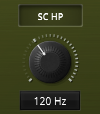 | SC HP is the sidechain highpass filter. Usually compressors overreact to low frequencies causing them to “duck” the highs and mids. The highpass filter makes it possible to filter out the low frequencies which prevents them from triggering the compression. The “SC HP” button will enable/disable the highpass filtering. The “SC HP” knob sets the cutoff frequency of the highpass filter. The filter also has a variable slope in which higher frequencies will have a smoother slope and smoother action. Note: If the “SC HP” button is disabled the highpass filter becomes inactive and a fixed -3 dB lowshelf filter is used instead. This works quite well on the mix bus. |
Threshold
 | Threshold sets the level where the input signal must pass for the compression to begin. The position of this point depends on what you’re trying to achieve:
|
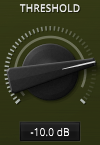 | Tip: The circular input level meter around the Threshold knob can be used to set the threshold position. |
Knee
| Knee sets the rate where the compressor attains full compression as soon as the threshold has been exceeded. Molotok is a soft-knee compressor, which means some amount of compression occurs even when the input signal is far from the threshold. A knee value of 0.5 will sound the most natural. Lower values will lead to lighter compression. Higher values will increase the “bend” of the transfer curve leading to a slight boost in gain just before the gain reduction starts. Tip: To achieve that esteemed “hammer-like” behavior, set the knee to maximum and adjust the threshold to enhance the transients. |
Gain Reduction Display
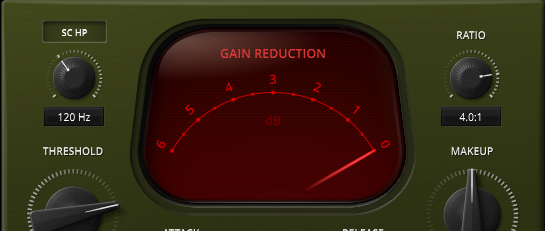
The Gain Reduction Display is a VU-style meter that can show either the “gain reduction” mode or the “total gain” mode. Click on the mode name to toggle between the two. In “gain reduction” mode the meter displays the gain reduction caused by the compression. In “total gain” mode the action is similar to the makeup knob circular meter, which shows the gain change caused by the input gain, the compressor’s gain reduction, and the makeup gain. The meter scale range functions automatically but can also be manually changed by clicking on the left or right side of the meter.
Tip: Right-click on the Gain Reduction Display to open its context menu. Here you can set the meter mode and meter range.
Tip: Hover the mouse over the Gain Reduction Display then use the scroll wheel to set the meter range.
Attack
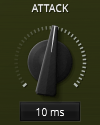 | Attack sets the speed of gain reduction. Setting the attack to low values will prevent transients from passing through, but at the expense of creating higher distortion levels. For extremely short values, less than 1 ms, the compressor becomes a distortion generator. Tip: Adjust the attack time to where it sounds natural while also enhancing the original sound. |
α–β–σ (Alpha–Beta–Sigma) Weighting
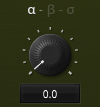 | α–β–σ (alpha–beta–sigma) weighting sets the compression style. In “alpha” mode the compressor reacts almost immediately. In “beta” mode a dual-stage release circuit is activated, which reduces over-compression artifacts on complex program material. In “sigma” mode the compressor action is delayed and the attack passes through almost untouched. Tip: “Alpha” and “Sigma” modes are good for tracking, i.e. compressing individual tracks. “Beta” mode is better suited for bus compression. |
Release
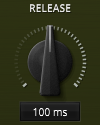 | Release sets the time that needs to pass for the compression to return to unity after the input signal drops below the threshold level. There might be a tendency to set fast release times in order to avoid over-compression. Please note that fast release times will yield higher distortion levels. For extremely fast release times (50 ms or less) the compressor may start to distort, which may not be a favorable effect on low frequency sounds. Tip: Try setting the release time to sound natural with some movement to the sound. You may find it useful to use the visual feedback from the gain reduction meter while making this adjustment. |
Ratio
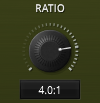 | Ratio determines the amount of gain reduction that gets applied as the input signal exceeds the threshold level. For example, applying a compression ratio of 2:1 means any input level that is 2 dB above the threshold will be attenuated, thus resulting in an output level 1 dB over the threshold. The ratio range is from 1.1:1 to 10.9:1. Tip: Sometimes it’s easier to setup the attack and release times using a high ratio and then reduce it afterward to the desired amount. |
Makeup
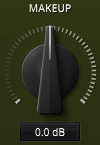 | Makeup allows you to adjust the signal level to compensate for changes in loudness caused by gain reduction. |
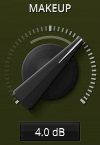 | Tip: The circular meter around the Makeup knob increases counterclockwise to indicate gain reduction. It also rotates jointly during knob changes to display post compression gain adjustments. It can be used as a guide to compensate for the change in signal level by keeping the 0 dB point in the center area of the the meter’s line. |
Dry Mix
| Dry Mix sets the balance between the original signal (dry) and the compressed signal (wet). As an example, at 25% the output will be 25% dry and 75% wet. Setting the Dry Mix knob to 0% will only pass the processed signal (100% wet). Setting the Dry Mix knob to 100% will only pass the unprocessed input signal (100% dry). The Dry Mix control provides an additional way to reduce the amount of compression. The Dry Mix is usually used on aggressively compressed material in order to reduce distortion levels and return some of the transients back. Note: The dry signal is not affected by the Input gain or Makeup gain. If the processed signal has the same loudness as the unprocessed signal, then the Dry Mix control will provide a seamless blend of the two. Note: The gain reduction meters and total gain meters are affected by the “Dry Mix” control and will display a reduced “real” reduction. |
Bypass
 | Bypass allows the input signal to pass through the plugin without any dynamics processing. |
Delta
| Delta outputs the difference between the input signal and the output signal. This allows you to hear only the processing changes of the signal in isolation. In “delta” mode only the compressor is active and the EQ, Limiter, Saturation, and Makeup are inactive. Tip: Use the “Delta” mode to help fine-tune any subtle/invisible compression. |
Out Gain
| Out Gain sets the overall output signal level after processing. This gain can be used to compensate for level changes introduced by the compressor. |
Toolbar
Undo/Redo
| Use the undo/redo buttons to recall previous/next parameter changes. The exact event is shown in a tool tip. Please note that certain parameter changes are not tracked by this function (e.g. “Bypass”). |
Preset Management
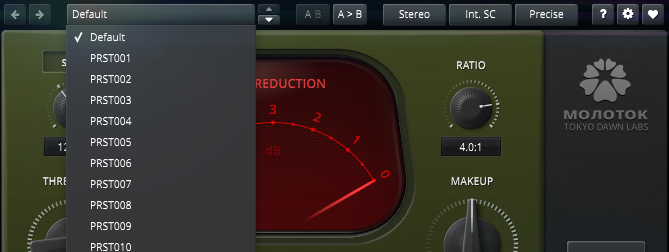
The preset drop-down list offers quick access to factory settings and user presets.
| The next/previous buttons allow you to cycle through the presets. |
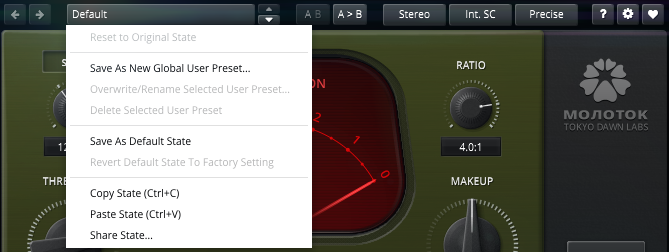
Reset to Original state resets the currently active preset to its original state.
Save As New Global User Preset opens a dialog used to create User Presets. Note that these presets persist across sessions and DAWs (presets are saved on your machine). The total amount of user presets is limited to 20.
Overwrite/Rename Selected User-Preset allows to overwrite or rename presets.
Delete Selected User Preset allows to delete the current user preset.
Save As Default State replaces the plugins’ default preset with the current parameter state.
Revert Default State To Factory Setting deletes an overwritten default state.
Copy State (Ctrl+C) copies the current control states to the clipboard. This allows for applying control states (i.e. “presets”) across plugin instances and plugin hosts by using the Paste State command.
Paste State (Ctrl+V) pastes the control states from the clipboard.
Tip: Control states (presets) can also be copied from Molotok to Molot GE. To copy the control states, select Copy State (Ctrl+C) in Molotok’s preset drop-down menu then select Paste State (Ctrl+V) in Molot GE’s preset drop-down menu.
Share State opens a dialog with additional preset sharing options via e-mail or internet forums.
A/B Control
| A/B allows to compare two alternative control settings. |
| A>B and B<A copies one state to the other. |
Stereo Configuration

The audio input can be processed in two different channel modes:
- Stereo processes the left and right channels.
- Mono processes the left channel only. The right output channel will be the same as the left output channel.
| Important: The Stereo Configuration button displays as inactive when the plugin is inserted on a mono or multi-mono track. This feature is not supported in all hosts. |
Sidechain Input

Int. SC/Ext. SC switches between the internal sidechain input and the external sidechain input. This can be used to “duck” one track by another. You’ll also need to route the external sidechain signal to the plugin sidechain input when:
- Routing external sidechain signals to plugin inputs 3/4 in stereo or to input 2 in mono (VST 2).
- Enabling the external sidechain input on the native DAW toolbar of the plugin window, which allows for using the sidechain routing capabilities provided by the DAW (VST3/AU/AAX).
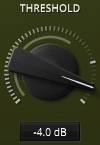 | Tip: Upon successful routing, the circular meter around the “THRESHOLD” knob will display the external sidechain signal level. |
Important (Pro Tools only): The sidechain button displays as inactive when no external sidechain signal (key input) is selected.

The sidechain button becomes active once the key input has been selected.

Processing Quality

Molotok offers three different processing quality modes:
- Live – A zero latency mode used for live tracking situations.
- Eco – An economic CPU efficient mode used when CPU processing is limited.
- Precise – The default high fidelity processing mode.
Help
| The dynamic help mode offers detailed information about the various elements of the user interface. Click “?” to activate the online help and move the mouse cursor over the control of interest. A small info bubble will appear displaying the function and details of the item. |
Settings
| The settings button opens a dialog which gives control over additional plugin options. |
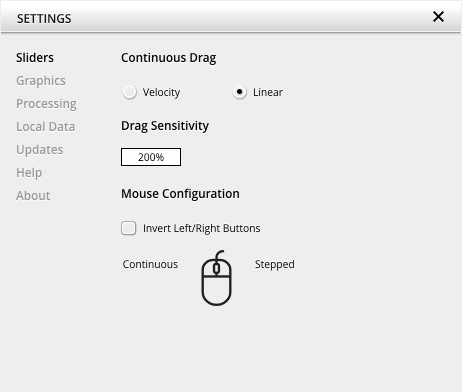
Slider allows for changing the behavior of knobs and control points in response to the mouse. Under Continuous Drag, knob and controller movement relies on mouse speed when Velocity is enabled. When Linear is enabled, knob and controller movement is proportional to mouse movement. Drag Sensitivity sets the linear sensitivity of the knob and controller movement further.
Plug-in controls, knobs, and control points can be adjusted using Left-click & drag (Continuous) and Right-click & drag (Stepped) by default. Mouse Configuration swaps the Continuous and Stepped behaviors between the left and right mouse buttons when selecting Invert Left/Right Buttons. Note that the default stepped values can be customized via the product configuration file. See “Local data” below for instructions on how to access this file.
Graphics allows for changing the interface size to a fixed percentage value between 100%, 125% and 150%.
Processing shows the plug-in latency and sample rate details. Highest quality rendering enables the option to always render at the highest Processing Quality, no matter what type is enabled in the Toolbar. See the “Processing Quality” subchapter for more details on these modes.
Registration offers access to offline and online product registration options. See the “Product Registration” chapter for more information.
Local Data allows for exporting and importing user preferences, presets, and keys, to and from other systems. Local data can also be deleted for all Tokyo Dawn Labs plug-ins using the Trash Can button.
In addition, the Folder button opens the Tokyo Dawn Labs local data folder containing all configuration files and keys. Note that these operations affect all TDR plug-ins, and not just Molotok.
Updates allows to Check for updates and to Download latest version. Automatic Lookups can be enabled to Check for updates (once per day).
Help contains Documentation and Support links.
About shows the version number, build date, format, credits, and other information.
Molot GE Upgrade
| This button opens the Molot GE product page on the Tokyo Dawn Website in your default browser. For more detailed control over processing, please consider upgrading to the enhanced Molot GE version. |
Context Menus
Standard Context Menu
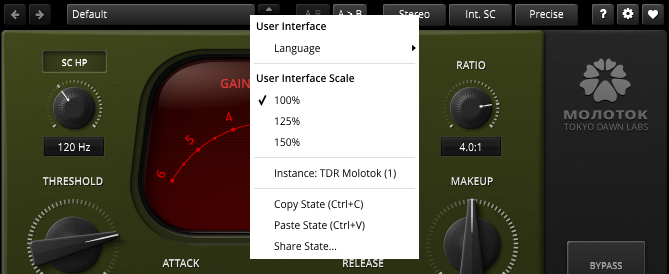
Additional options can be accessed using the standard context menu. This can be opened by Right-clicking on a blank area anywhere in the UI. A click outside of the menu closes it.
User Interface offers language options.
- Language
- English displays the English language in the UI.
- Russian displays the Russian language in the UI.
User Interface Scale sets the on-screen interface size to a fixed percentage value of 100%, 125%, or 150%.
Instance allows for renaming the specific plug-in instance.
Copy State (Ctrl+C) copies the current control states to the clipboard. This allows for applying control states (i.e. “presets”) across plugin instances and plugin hosts by using the Paste State command.
Paste State (Ctrl+V) pastes the control states from the clipboard.
Tip: Control states (presets) can also be copied from Molotok to Molot GE. To copy the control states, select Copy State (Ctrl+C) in Molotok’s context menu then select Paste State (Ctrl+V) in Molot GE’s context menu.
Share State opens a dialog with additional preset sharing options via e-mail or internet forums.
Gain Reduction Display Context Menu
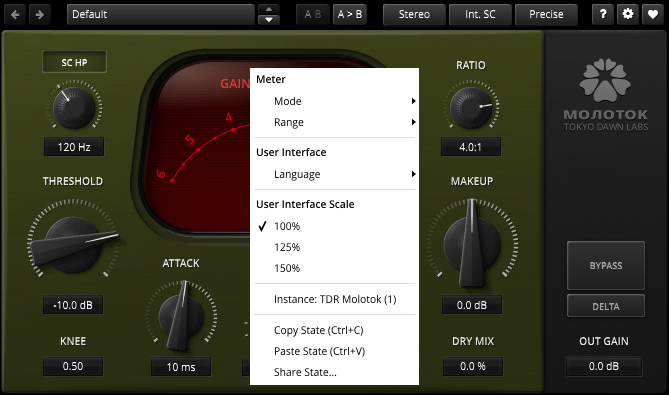
The gain reduction display context menu provides additional options. This can be opened by Right-clicking anywhere on the gain reduction display. A click outside of the menu closes it.
Meter provides several options for configuring.
- Mode
- Relative displays the gain reduction caused by the compression.
- Absolute shows the gain change caused by the input gain, the compressor’s gain reduction, and the makeup gain.
- Range sets the meter range to 2 dB, 3 dB, 4 dB, 6 dB, 9 dB, 12 dB, 18 dB, 24 dB, or 32 dB.
User Interface offers language options.
- Language
- English displays the English language in the UI.
- Russian displays the Russian language in the UI.
User Interface Scale sets the on-screen interface size to a fixed percentage value of 100%, 125%, or 150%.
Instance allows for renaming the specific plug-in instance.
Copy State (Ctrl+C) copies the current control states to the clipboard. This allows for applying control states (i.e. “presets”) across plugin instances and plugin hosts by using the Paste State command.
Paste State (Ctrl+V) pastes the control states from the clipboard.
Tip: Control states (presets) can also be copied from Molotok to Molot GE. To copy the control states, select Copy State (Ctrl+C) in Molotok’s context menu then select Paste State (Ctrl+V) in Molot GE’s context menu.
Share State opens a dialog with additional preset sharing options via e-mail or internet forums.


